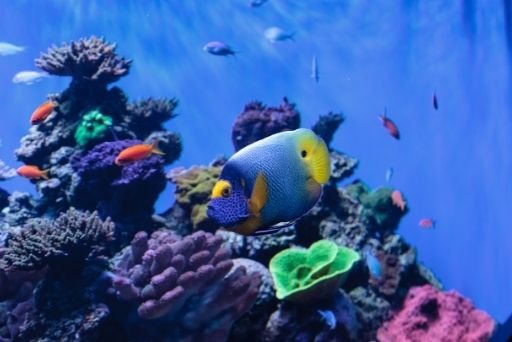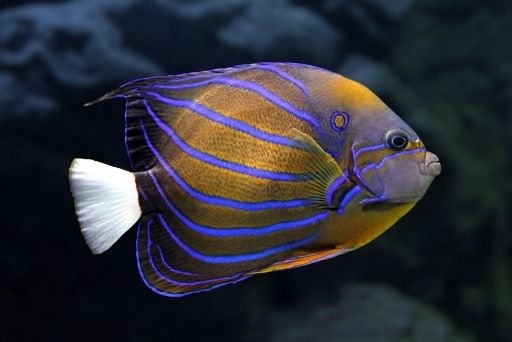What should you know about the Blue-faced angelfish (Pomacanthus xanthometopon)
Have you ever tried scuba diving? Isn’t it beautiful to look at the variety of fish species underwater with spread coral reefs? The bright colour fishes instantly catch our attraction because of their striking colouration. One such species is the Blue-Faced Angelfish. Its binomial name is Pomacanthus Xanthometopon. It belongs to the Chordata phylum and Actinopterygii class. The Blue-Faced Angelfish has a striking facial colouration found in the shallow parts of the Indo-Pacific ocean. Know more as you read.
Physical attributes of the Blue-Faced Angelfish
The body of the Blue-Faced Angelfish is oval-shaped. It is bluish with a beautiful blend of yellow in certain parts. The dorsal fins and anal fins are blue with a lime yellow lining in the edges. The dorsal fins consist of 13 spines and 20 soft rays, and the anal fin has three spines with 18 to 20 soft rays.
The Blue-Faced Angelfish have very small mouths and tiny teeth, and their face colour is yellow. The juvenile Angelfish are dark blue with yellow streaks. It is a very small-sized fish that weighs around 2 lb (0.9 kg). However, he weight of the fish may vary following their surroundings.

Habitat of Blue-Faced Angelfish
The Blue-Faced Angelfishes are mostly seen in the Indo-Pacific, from the Maldives to Vanuatu. They are native to tropical South America, and it grows to a length of about 15 cm. They are widespread in Florida too. In addition to this, they are also found in the Gulf of Mexico.
Diet of Blue-Faced Angelfish
The Blue-Faced Angelfish can turn territorial when kept in a tank. The diet of such fish is Spirulina, marine algae. Mysis, frozen shrimp and other meaty items also add to the diet of the fish. They are omnivorous and eat meatier food. Their natural diet consists of worms and small crustaceans. They also thrive for Shrimp Pellets and Tropical Granules. Amidst this, they generally eat three to four times a day to survive.

Behaviour and temperament
The Blue-Faced Angelfish are semi-aggressive and can become territorial if they are the only largest among the group. They do not combine with other Angelfish species, and they are very sensitive to poor water quality. They are not great community fish either. However, their semi-aggressive nature makes them pretty good. Fishes of their kind make Blue Angelfish very aggressive like any other Cichlids. They may even fight with other Angelfishes.
Breeding of Blue-Faced Angelfish
The Blue-Faced Angelfish reach their sexual maturity between 6 to 12 months. They form monogamous pairs. The eggs are laid on a vertical surface with an artificial spawning site. They select their mates for reproduction. Before the female lays eggs, the surface is cleaned for about 24 hours.
Once the female Angelfish lays the egg, she follows behind her and fertilizes the egg. The pattern is repeated several times. The parents look after their eggs until they are hatched. The Blue-Faced Angelfish are not prone to eating their babies though. When these species are prepared to spawn, they pair up and defend their territory by scaring away other fishes.

Lifecycle of the Blue-Faced Angelfish
Blue-Faced Angelfish are very famous freshwater fishes known for their beauty and variety. They can live up to 10 to 12 years and reach 6 to 12 inches. This size of the Angelfish only elongates when it is kept with pristine tank care. The Blue-Faced Angelfish begins to transform into their adult colouration when they reach up to 2.7 to 4.7 inches. As such, the life span of the Angelfish can go up to 21 years when kept in captivity.
Adaptation of the Blue-Faced Angelfish
The Blue-Faced Angelfish is mostly found on the coral reefs in the Eastern part of the Indo-Pacific. It consists of the Maldive Islands, Malaysia, Indonesia, Japan, Taiwan, Northern Australia and the Philippines. Sometimes it is also seen off the coast of Florida. It resides in the lagoons, outer reefs, slopes and deep down channels. The juvenile Blue Angelfishes are frequently seen inside caves, among the rocks. The depth they stay in is about 25 m (82 ft).

Facts about the Blue-Faced Angelfish
A Blue-Faced Angelfish communicates with other animals by taking the help of chemical signals in urine and bile, which they release into the water. They are not very active swimmers and prefer to live in slow-moving water. The Blue-Faced Angelfish, despite being aggressive, do not pose any threats to humans.
They are generally aggressive during the time of breeding. Pecking and or nipping are signs of their aggressiveness. The main predators of Blue Angelfish are larger fishes, Barracudas and sharks. The Blue-Faced Angelfish are generally seen living in pairs, and Queen Angelfish is believed to be monogamous.
The bottom line
There is no accurate total number of Blue-Faced Angelfishes in the world or as exotic pets. They are seen in large populations in the freshwater. They are extremely small fishes with adorable looks. Their bright body colouration instantly catches the attention of the people. They also prefer to live in slow-moving water with a composed environment.




